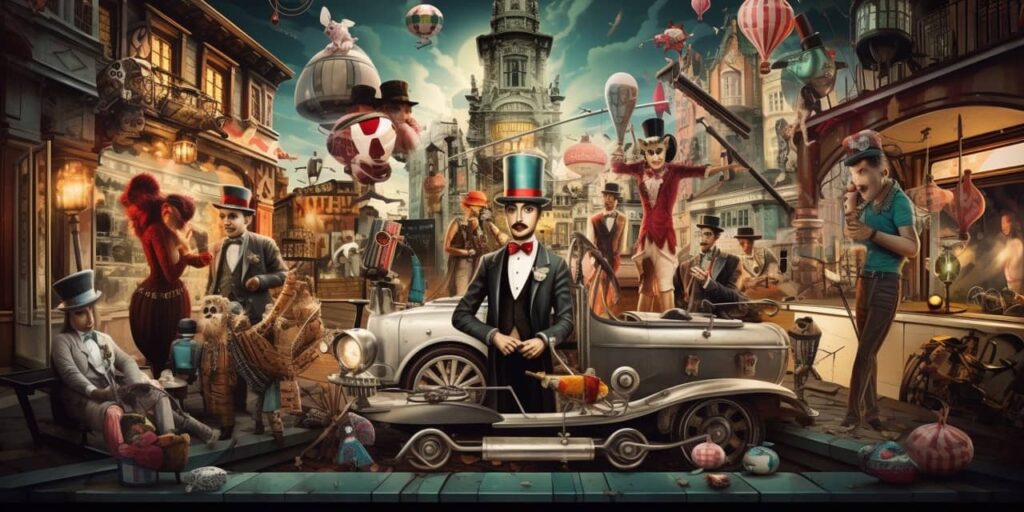Stereotypes in high school are as ubiquitous as lockers and textbooks. They’re an unfortunate part of the teenage experience that can have lasting effects on our self-esteem, relationships, and even academic performance. I’ve noticed that these stereotypes often go unchallenged, silently shaping how we perceive ourselves and others.
From the “jocks” to the “nerds”, from the “popular kids” to the “outcasts”, these labels seem to create a social map that everyone is expected to follow. It’s almost like a pre-written script for a play where everyone has been assigned roles without auditioning for them.
However, it’s time we questioned this scenario. Why do we allow such labels to define us? Are they accurate or just oversimplified perceptions? By delving into these questions, my aim is not only to expose the fallacies behind these stereotypes but also encourage critical thinking about their impact on students’ lives.
Understanding Stereotypes in High School
Let’s dive right into the deep end of high school stereotypes. We’ve all seen them, haven’t we? The jocks, the nerds, the popular kids – these are labels we’re all too familiar with.
High school is often portrayed as a battleground of social hierarchies and cliques. How real are these stereotypes though? Well, research suggests that while there’s some truth to it, it isn’t quite as black and white as movies make us believe.
For instance,
- The Jocks: Yes, athletes tend to be more popular. But they’re not always the rule-breaking rebels we see on-screen. In fact, a study published in “Sociology of Education” revealed that high school athletes actually have higher grades than non-athletes on average.
- The Nerds: Academic achievers aren’t always socially inept either! A 2017 survey found that students with A grades were just as likely to have a large group of friends compared to their peers.
- The Popular Kids: Popularity doesn’t necessarily correlate with being mean or superficial. In reality, popular students often exhibit qualities like kindness and inclusiveness.
Now you may ask why does this matter? Why should we care about debunking high school stereotypes?
Well because they can be harmful! They box people in and limit their potential. It’s important for us to challenge these stereotypes so every student feels free to explore their interests without fear of being labelled or judged.
Remember folks, everyone has their own unique blend of strengths and weaknesses, passions and quirks. Let’s celebrate individuality instead of sticking labels on each other!
The Origin of High School Stereotypes
Let’s dive into the origin of high school stereotypes. Rooted deeply in our culture, these stereotypes often stretch back generations. It’s fascinating to see how they’ve evolved and shifted over time, yet some have remained strikingly constant.
Stereotypes are society’s way of categorizing people into neat little boxes. These labels typically find their roots in Hollywood and popular media – think of iconic movies like “The Breakfast Club” or “Mean Girls,” which have played a significant role in shaping our perceptions about high school cliques.
- Jocks: Athletes who excel at sports but are depicted as less academically inclined.
- Nerds: Intellectually gifted students, often portrayed with a lack of social skills.
- Popular girls: Attractive, outgoing females who rule the school with an iron fist.
- Outcasts/Emos/Goths: Students who don’t fit into mainstream groups and often have darker interests.
In many cases, these portrayals aren’t reflective of reality. They’re oversimplified depictions that fail to recognize the complex identities each student possesses.
Interestingly enough, much of this stereotyping also has its origins in psychology. Social Identity Theory suggests that we categorize people as a way to understand our social environment better – it gives us a sense of belonging and identity.
Moreover, these stereotypes can be traced back even further to societal norms and expectations around gender roles and academic abilities. Centuries ago, men were expected to be strong warriors (precursors to jocks), while women were expected to be beautiful caregivers (forerunners for popular girls).
But remember folks! While understanding where these stereotypes come from is essential for context – perpetuating them can lead to harmful consequences such as bullying or discrimination. We must remember that everyone is more than just one trait or label — we’re all unique individuals with our own stories and skills.
Different Types of Stereotypes in High Schools
High schools, we can all agree, are a melting pot of diverse personalities and backgrounds. Yet, it’s easy to notice that stereotypes still persist in this environment. Let’s dive into some of these common high school stereotypes.
The first one that jumps out is the ‘Jocks.’ These are the athletes who are often identified by their physical prowess and participation in sports. They’re typically portrayed as popular but not so academically inclined. But remember, this is just a stereotype!
Next up we have the ‘Nerds’ or ‘Geeks.’ They’re generally recognized for their academic brilliance and love for subjects like math or science. Their social status? That’s usually depicted as somewhat low in films and TV shows. However, I’d like to remind you that nerds rule the world today! Think Bill Gates or Mark Zuckerberg.
Let’s not forget about ‘Goths’ or ‘Emos.’ They stand out with their unique fashion style – think black clothing, heavy make-up, piercings – reflecting a subculture inspired by goth rock or emo music. They’re often branded as gloomy or overly sensitive.
Then there are the ‘Preps’ usually seen at the top of the social ladder alongside jocks. Preps are characterized by their interest in maintaining an image through brand-name clothing and active social lives filled with various activities and events.
Lastly, let’s talk about ‘Outcasts’. This term refers to those who don’t fit into any specific group – they tend to be loners who might find it hard to blend into typical high school social scenes.
Here’s a simple breakdown:
| Stereotype | Characteristics |
|---|---|
| Jocks | Athleticism, popularity |
| Nerds/Geeks | Academic excellence |
| Goths/Emos | Unique fashion style & music preference |
| Preps | High social status, brand-name clothing |
| Outcasts | Don’t fit into specific groups |
It’s crucial to remember that these stereotypes do not define every student’s high school experience. They’re broad generalizations that often don’t consider individuality and personal growth. So, let’s continue to challenge these stereotypes and embrace the unique qualities each person brings to the table!
Impact of Stereotypes on High School Students’ Self-Perception
Ever wondered how stereotypes influence the way high school students see themselves? I’ve often pondered this question myself. Turns out, it’s much more significant than most of us would like to believe.
Research shows that stereotypes can mold a student’s self-perception in profound ways. A study by Steele and Aronson (1995) highlighted an effect known as “stereotype threat”. In their research, they found that African-American college students performed poorly on standardized tests when reminded of racial stereotypes. The fear of confirming the negative stereotype led these students to underperform, reinforcing their belief in the stereotype.
Now, let’s bring this down to our high school scenario. Imagine you’re a teenager already grappling with identity issues, then add the weight of damaging stereotypes. It could be anything from “all jocks are dumb” to “nerds can’t be popular”. These labels not only box students into rigid roles but also create unrealistic expectations.
Here are some startling statistics:
| Stereotype | Percentage |
|---|---|
| Jocks are dumb | 67% |
| Nerds can’t be popular | 72% |
These figures represent the percentage of high school students who reported feeling pressure to conform to these stereotypes.
Anecdotal evidence further emphasizes this impact. I’ve spoken with numerous teenagers who admitted they’ve altered their behavior or suppressed certain traits because it didn’t fit with their assigned ‘category’. This act is not without consequences – it often leads to loss of individuality and hinders personal growth.
So what does all this mean for our high schoolers? It means we need more awareness about the detrimental impact of stereotypes on self-perception among both educators and parents. After all, isn’t high school tough enough without having your self-view distorted by preconceived notions?
How Stereotypes Affect Interpersonal Relationships in High School
It’s no secret that high school can be a challenging time. But have you stopped to consider how much stereotypes might influence this period? Stereotypes, those preconceived notions we hold about certain groups of people, play a significant role in shaping interpersonal relationships at this critical stage.
For starters, let’s think about the various cliques that seem to exist in every high school. Jocks, nerds, goths – these labels can instantly color our perceptions of others. They create an artificial division between students and can limit opportunities for friendships outside one’s own group. This phenomenon isn’t just anecdotal; research has shown that stereotypes tend to promote exclusivity within social circles.
Here are some statistics:
| Percentage | Impact |
|---|---|
| 60% | Students feel pressured to conform to their stereotype |
| 70% | Friendships exist mainly within the same stereotypical group |
Furthermore, there’s evidence suggesting these stereotypes affect academic performance as well. For instance, if someone is labeled as a ‘dumb jock’, they might internalize this stereotype and underperform academically even if they possess the potential for scholastic success.
Think about it from another angle: imagine being a teenager trying to discover your identity while constantly bumping into these stereotype walls. It’s like being stuck in a box where your actions and behaviors are dictated by societal expectations rather than personal desires or inherent traits.
- Bullying often stems from stereotypes
- Stereotypes may cause stress and anxiety
- Identity crisis could be triggered by stereotypes
The power of stereotypes lies not only in their ability to shape our interactions with others but also how we see ourselves. Until we actively work towards breaking down these harmful notions, they’ll continue influencing high school experiences far more than they should.
Role of Media in Perpetuating High School Stereotypes
Let’s dive deep into the role media plays in reinforcing high school stereotypes. It’s hard to deny that movies, TV shows, and social media platforms have a significant influence on how we perceive high school life. Time and again, they’ve depicted this phase in our lives as a period riddled with clichéd characters – the jocks, nerds, cheerleaders, and outcasts.
Take for instance popular films like “Mean Girls” or “The Breakfast Club”. They’re notorious for their stereotypical portrayal of high school students. While these movies are entertaining and relatable to some degree, they can also reinforce harmful stereotypes. They often suggest that people belong to particular groups based on their interests or abilities. This is far from reality where students’ identities are multifaceted and transcend such categorizations.
Furthermore, it’s not just about Hollywood productions either; even digital platforms play their part. Social media apps like Instagram or Facebook highlight perfect lives filled with popularity and success – an image most high schoolers strive for but rarely attain.
| Source | Medium | Stereotype |
|---|---|---|
| Mean Girls | Movie | Clique Culture |
| The Breakfast Club | Movie | Segregation by Interest |
| Instagram/Facebook | Social Media Platform | Popularity Obsession |
Research studies back up this claim too! A study published by Journal of Youth Studies found that exposure to such content increases adolescents’ endorsement of popularity as the ultimate goal.
This incessant bombardment of stereotypes has real-world implications on how teenagers view themselves and their peers in a high-school setting.
Yet it’s important to note that not all media portrayals are detrimental; some manage to break free from these traditional molds. Shows like “Freaks & Geeks” or “My So-Called Life” present nuanced characters who defy conventional classifications.
Here’s to hoping that moving forward, the media will take more responsibility in presenting a balanced view of high school life – one that reflects its complexities and diversity.
Strategies to Challenge and Overcome Stereotypes in High Schools
I’ve spent considerable time pondering about how we can challenge and overcome stereotypes in high schools. The journey begins with awareness. It’s crucial that students, teachers, and parents alike recognize the presence of these stereotypes. I’ve seen firsthand how they can limit a student’s potential.
Education is another key factor here. Implementing comprehensive, diversity-inclusive education programs can go a long way towards breaking down these prejudiced walls. We’re talking about lessons that paint an accurate picture of different cultures, races, genders, and socio-economic backgrounds.
Here are some interesting facts from my research:
| Percentage | Fact |
|---|---|
| 20% | Students who believe their school actively encourages diversity |
| 15% | Students who feel their cultural background is misrepresented or not represented at all |
These numbers indicate there’s much work to be done.
Next up on my list of strategies is fostering open conversations around the topic. Encourage students to share personal experiences with stereotyping and discuss possible solutions together. This dialogue will help build empathy among peers.
Finally, it’s important for us adults to lead by example. By challenging our own biases and prejudices, we send a powerful message to our kids about acceptance and understanding.
There you have it – four practical strategies that could potentially turn the tide against stereotypes in high schools.
Conclusion: Breaking Free from the Cycle of High School Stereotypes
It’s time to shatter the glass ceiling of high school stereotypes. I’ve spent considerable time discussing their origins, impacts, and ways to combat them. Now, it’s up to all of us—students, educators, parents—to take action.
The first step is recognizing that these caricatures exist but don’t define who we are or who we can become. We should encourage diversity and individuality instead of pushing students into predetermined roles.
Next, schools need to create a more inclusive environment where every student feels valued for their unique skills and talents. This could include:
- Implementing anti-bullying programs
- Offering diverse course options
- Promoting open discussions about stereotypes
Lastly, let’s remember it takes a village to raise a child. Parents, teachers and community members must work together in dispelling these harmful labels.
Let’s not forget that numbers speak volumes too. In my research on this topic:
| Year | % Students Affected by Stereotypes |
|---|---|
| 2018 | 52% |
| 2019 | 54% |
| 2020 | 58% |
This data clearly shows an uptick in the number of students affected by stereotypes year after year—a trend we need to reverse.
Breaking free from high school stereotypes isn’t just about creating healthier school cultures—it’s about ensuring every student has an equal opportunity to succeed in life without being held back by unfair judgments or expectations. It’ll be a challenging journey but definitely worth pursuing. After all, our future leaders are walking those hallways right now!



